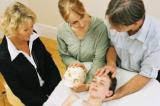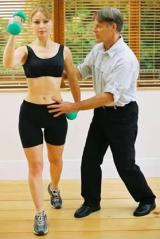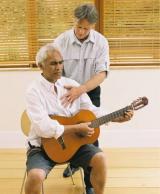Structural Integration is an innovative approach to well-being that recognizes a natural order inherent in the human being. When the musculo-skeletal system is re-balanced and re-aligned and optimal movement restored, our innate self-healing abilities stimulate a new vitality. The Structural Integration series is a sequence of 10 sessions designed to restore natural structure and function. Specific myofascial techniques, movement repatterning, guided awareness are some of the tools that a practitioner will use to guide a client to a new balance. The essence of Structural Integration is to foster growth, an expansion of body awareness and conscious choice to bring aliveness, alignment and fluidity to daily body use.
Good usage is not simply a new set of patterns that you learn but an ongoing discovery process of how to best use your changing body in a changing world. - Judith Aston, Founder of Aston Patterning
The Structural Integration Practitioner Training: Who is it For?
Body therapy and movement practitioners and those with experience in related fields such as fitness, physical education, counselling, medicine, yoga, the martial arts and other movement fields, will find the skills and knowledge invaluable in the development of an integrative approach to the body. For some people the Structural Integration training is the beginning of a whole new career, a complete change of direction in their working life. For others, the insights and methods provide a new synthesis allowing them to expand and refine their approach and techniques in an existing field.
A career in Structural Integration is a challenging and rewarding opportunity. If you have a vision of integrating your life into the fascinating and growing field of holistic health, then perhaps this is for you.
 The Structural Integration Training is a comprehensive and holistic educational programme both for those aspiring to practice as bodywork and movement professionals and those already working in the field. The ideal learning environment is created with the use of innovative techniques that work with the whole person and appreciate individual differences and needs.
The Structural Integration Training is a comprehensive and holistic educational programme both for those aspiring to practice as bodywork and movement professionals and those already working in the field. The ideal learning environment is created with the use of innovative techniques that work with the whole person and appreciate individual differences and needs.
The Training Format
Training Prerequisites and the Application Process
The main prerequisites for working in this area of healing and empowerment are emotional, mental and spiritual maturity and a willingness and commitment to learn. It is also essential that applicants who would like to enter the Practitioner Training have a basic knowledge in myofascial and therapeutic touch techniques, the healing relationship, principles of human movement and structure, and musculo-skeletal anatomy.
It is recommended that applicants complete the 5-Section MIT Myofascial Integration Training to satisfy this requirement. The Myofascial Training is comprised of two 9-day sections each followed by home study and practice sessions, and a 3-day certification class. For applicants from countries where this is not possible equivalent experience and/or private tutoring by MIT- approved teachers is permitted.
- Applicants must receive the Structural Integration 10 series from a MIT-approved practitioner.
- Applicants must submit an application. The form is available from MIT NZ or Europe.
- Applicants must attend a selection interview with 2 MIT faculty members to assess your readiness to enter the training. The selection fee is GBP 50 or $NZ100.
- Fees for the New Zealand and European Trainings
- The full tuition fee for all 5 modules is GBP 5,500 or NZ$13,750 paid in instalments through the training time. This does not include food and accommodation cost if modules are held at residential centres.
For more information contact:
New Zealand/Australia:
Sol Petersen, Waimana, Coromandel RD1, NZ
Phone 64-7-8668971 or 64-21 893055, sol@theradiantbody.com
Europe:
Tine Langkilde, 10 Madvigs Alle,1829 Frederiksberg, Copenhagen,Denmark
Phone 45-21458017 or 45-44648017, tine@langkilde.dk
UK: Mark Gray, 40 Mountview Rd, Stroud Green, London N44HX,
Phone 44-208 3478680, mark@markgray.info
www.theradiantbody.com
Some of our Structural Integration practitioners speak about how they experienced the training:
As a podiatrist and sports therapist I found that the Structural Integration training provided me with many of the answers that I had been looking for as to how imbalance occurs in the human being and how we may assist others to expand their embodied self development and to be pain free. I recommend the training to those at all levels through to the experienced practitioners who dare to be open enough to question the process of pathology and explore the dynamics of healing.
Richard Pannell, Podiatrist and Sports Therapist, UK
In my work at Massey University, I have been seeking for years to develop a view of education that encompasses the whole person. Structural Integration has given me that and has also helped me to reshape my courses for the student teachers. As a practitioner I find it very satisfying to be a catalyst for people to develop their awareness, their understanding, their power and their sense of ease.
Neville Kennedy, Physical Education Lecturer, Massey University, NZ
As a massage therapist I was very successful at releasing pain and tension but something was missing. How could I help people to stop creating the same tensions and use their body in a more balanced way? When I observed a Structural Integration treatment it was clear that I must learn this approach. Here were the elements I was missing.
I saw a session which was a mixture of a movement lesson and bodywork with a very fine awareness of body sensations and emotions. The client was not passive but participated with active movements on the table, seated or standing, all the while being guided in wakeful attention. The space of the session was a beautiful gentle way of listening, a loving presence which allowed the individual's needs and process to unfold without effort. My work as a therapist has changed radically - it has become more and more intuitive and satisfying. Now I see that my job is to assist clients to release their own pain and discover a new bodywisdom they can apply to their life."
Tine Langkilde, Massage Therapist, DenmarkThe Structural Integration training experience has totally revamped my work as a personal trainer. Now before I develop a training programme for anyone I use a mirror or photographs to help clients understand their structural alignment. If they aren't going through the 10 series with me then I give them a corrective stretch regime before they start resistance training to help balance their muscle groups and to avoid toning in compression. I also use many core stabilisation techniques to help support the spine. I now have a much more complete training system to help people to realise their potential. It is a gift to watch the beautiful unfolding of people, to see their joy and excitement with their new found freedom.
Rod Fielder, Personal Trainer, Auckland, NZ
The training experience was a surprising ambience of compassion and unconditional love. I learned a tremendous amount about the impact of touch on the emotional and psychic levels. I learned how to follow the body and to be comfortable with not knowing and I learned the basis of a psychotherapeutic approach for the body. I have discovered many new possibilities in the structure and movement of my body.
Angelika Koch, Gestalt Therapist, France
The training is presented in a format with modules of classroom learning time interspersed with supervised home practice and study over a 12 to 16 month period depending on the specific training. When possible the main teaching sections are held in residential settings which assists in the creation of an ideal co-operative learning environment.
The training is usually organised as follows:
Module 1 is offered in Europe or in NZ ; Modules 2-5 are offered both in New Zealand and Europe
The MIT training team is a group of highly experienced teachers from New Zealand, UK, Europe and the USA who have been working together for over 14 years running trainings in NZ and Europe. While being committed to Structural Integration, our teachers have also completed professional trainings in the Alexander Technique, Hakomi Experiential Psychology, Aston Movement Coaching, Osteopathy, Physiotherapy, CranioSacral Therapy, Aquatic Bodywork and much more. Their varied backgrounds gives our team a rich foundation to offer an overview and an integrative approach.
Structural Integration Training Format and Curriculum
Module 1 The Art of Structural Integration
6 weeks Incorect tag used in this page, please contact administrator to correct this page, thank you.
Principles, Concepts and Theory of Structural Integration
Principles, origins and evolution of Structural Integration. Concepts and theoretical basis for the 10 Series and the SI approach. Relationship of structure and function within the field of gravity. Influences on the body's integrity including injury, overuse, misuse, habitual patterns, attitudes and emotions.
The Healing Relationship
An introduction to a body psychotherapy approach. How emotions and meaning affect the bodywork process. Therapist-client relationship, boundaries, transference and counter-transference, safety, developing loving presence and the co-operative therapeutic relationship.
Communication Skills
Dialogue and rapport skills, tracking and working with emotions.
The Structural Integration 10 Series and Applications of SI
The basic 10 series, individually designed series, post series work and an SI approach to remedial work will be demonstrated, taught and practiced under supervision.
The Structural Integration 10 Series and Applications of SI
The basic 10 series, individually designed series, post series work and an SI approach to remedial work will be demonstrated, taught and practiced under supervision.
Anatomy, Physiology and Kinesiology
Neuromyofascial anatomy for structural and functional bodywork, palpation identification of key landmarks and tissues. Movement of the joints, complex movement patterns, contraindications.
Movement Education Concepts and Skills
Concepts of structure and movement in daily activities such as standing, sitting, walking - and specialised movement patterns associated with specific sports or occupations.
Assessment Skills
Body reading (stationary and in movement), palpation for hyper/hypo-tone, muscle length tests and other assessment methods for the structural, functional and energetic body. Photographs and body notation are used for visual assessment.
Bodywork Skills
Using a wide range of touch skills to effect change in the myofascial system, specific active and passive neuromyofascial and joint mobilization techniques.
Ergonomics and Selfcare
Applied movement skills and maintaining your own structural integrity as you work.
Setting up a Practice
Support in the development and promotion of a private practice.
We fix a washing machine, but one human being cannot fix another we can only help or hinder the person's process. The client's growth, unfolding and healing are all within. The therapist can only facilitate what is already there."
- Ron Kurtz, Founder of Hakomi Experiential Psychology
Module 2 Supervised Home Practice 16-24 weeks
During the two home practice phases student practitioners are required to take clients through the 10 series, keep comprehensive records of their sessions, submit videos of their work to an advisor and continue their study of Structural Integration. Students will complete exercises and material that will assist them in the development of a successful practice.
Module 3 The Advanced Series and Post Series Work 9 day class
This supervision class is designed to work on refining the basic series and learning advanced techniques in all aspects of the practice.
Module 4 Supervised Home Practice
24 weeks as per module 2.
Module 5 Advanced Supervision and Final Certification
5 day class Exploring applications of Structural Integration.
Continuing Education and Further Advanced Classes
Mana Integrative Therapies offers a range of post-training advanced classes psychotherapeutic skills, movement classes and myofascial skills, as well as a six week advanced Structural Integration training for those who have been practicing for at least two years.


